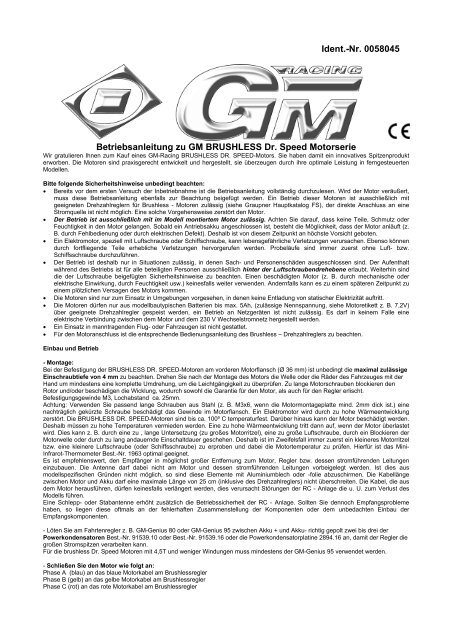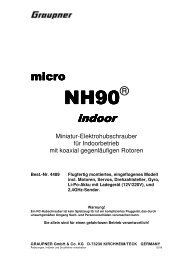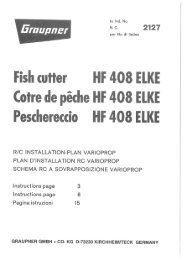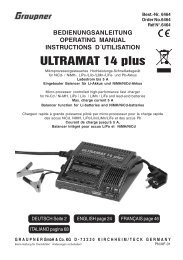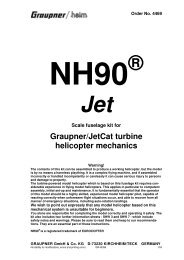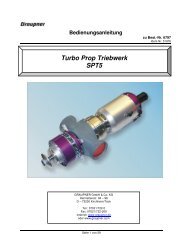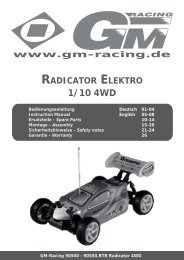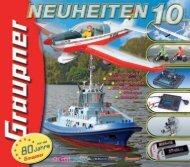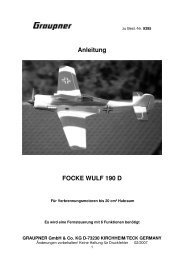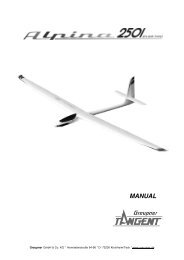Nr. 0058045 Betriebsanleitung zu GM BRUSHLESS Dr ... - Graupner
Nr. 0058045 Betriebsanleitung zu GM BRUSHLESS Dr ... - Graupner
Nr. 0058045 Betriebsanleitung zu GM BRUSHLESS Dr ... - Graupner
You also want an ePaper? Increase the reach of your titles
YUMPU automatically turns print PDFs into web optimized ePapers that Google loves.
Ident.-<strong>Nr</strong>. <strong>0058045</strong><br />
<strong>Betriebsanleitung</strong> <strong>zu</strong> <strong>GM</strong> <strong>BRUSHLESS</strong> <strong>Dr</strong>. Speed Motorserie<br />
Wir gratulieren Ihnen <strong>zu</strong>m Kauf eines <strong>GM</strong>-Racing <strong>BRUSHLESS</strong> DR. SPEED-Motors. Sie haben damit ein innovatives Spitzenprodukt<br />
erworben. Die Motoren sind praxisgerecht entwickelt und hergestellt, sie überzeugen durch ihre optimale Leistung in ferngesteuerten<br />
Modellen.<br />
Bitte folgende Sicherheitshinweise unbedingt beachten:<br />
• Bereits vor dem ersten Versuch der Inbetriebnahme ist die <strong>Betriebsanleitung</strong> vollständig durch<strong>zu</strong>lesen. Wird der Motor veräußert,<br />
muss diese <strong>Betriebsanleitung</strong> ebenfalls <strong>zu</strong>r Beachtung beigefügt werden. Ein Betrieb dieser Motoren ist ausschließlich mit<br />
geeigneten <strong>Dr</strong>ehzahlreglern für Brushless - Motoren <strong>zu</strong>lässig (siehe <strong>Graupner</strong> Hauptkatalog FS), der direkte Anschluss an eine<br />
Stromquelle ist nicht möglich. Eine solche Vorgehensweise zerstört den Motor.<br />
• Der Betrieb ist ausschließlich mit im Modell montiertem Motor <strong>zu</strong>lässig. Achten Sie darauf, dass keine Teile, Schmutz oder<br />
Feuchtigkeit in den Motor gelangen. Sobald ein Antriebsakku angeschlossen ist, besteht die Möglichkeit, dass der Motor anläuft (z.<br />
B. durch Fehlbedienung oder durch elektrischen Defekt). Deshalb ist von diesem Zeitpunkt an höchste Vorsicht geboten.<br />
• Ein Elektromotor, speziell mit Luftschraube oder Schiffschraube, kann lebensgefährliche Verlet<strong>zu</strong>ngen verursachen. Ebenso können<br />
durch fortfliegende Teile erhebliche Verlet<strong>zu</strong>ngen hervorgerufen werden. Probeläufe sind immer <strong>zu</strong>erst ohne Luft- bzw.<br />
Schiffsschraube durch<strong>zu</strong>führen.<br />
• Der Betrieb ist deshalb nur in Situationen <strong>zu</strong>lässig, in denen Sach- und Personenschäden ausgeschlossen sind. Der Aufenthalt<br />
während des Betriebs ist für alle beteiligten Personen ausschließlich hinter der Luftschraubendrehebene erlaubt. Weiterhin sind<br />
die der Luftschraube beigefügten Sicherheitshinweise <strong>zu</strong> beachten. Einen beschädigten Motor (z. B. durch mechanische oder<br />
elektrische Einwirkung, durch Feuchtigkeit usw.) keinesfalls weiter verwenden. Andernfalls kann es <strong>zu</strong> einem späteren Zeitpunkt <strong>zu</strong><br />
einem plötzlichen Versagen des Motors kommen.<br />
• Die Motoren sind nur <strong>zu</strong>m Einsatz in Umgebungen vorgesehen, in denen keine Entladung von statischer Elektrizität auftritt.<br />
• Die Motoren dürfen nur aus modellbautypischen Batterien bis max. 5Ah, (<strong>zu</strong>lässige Nennspannung, siehe Motoretikett z. B. 7,2V)<br />
über geeignete <strong>Dr</strong>ehzahlregler gespeist werden, ein Betrieb an Netzgeräten ist nicht <strong>zu</strong>lässig. Es darf in keinem Falle eine<br />
elektrische Verbindung zwischen dem Motor und dem 230 V Wechselstromnetz hergestellt werden.<br />
• Ein Einsatz in manntragenden Flug- oder Fahrzeugen ist nicht gestattet.<br />
• Für den Motoranschluss ist die entsprechende Bedienungsanleitung des Brushless – <strong>Dr</strong>ehzahlreglers <strong>zu</strong> beachten.<br />
Einbau und Betrieb<br />
- Montage:<br />
Bei der Befestigung der <strong>BRUSHLESS</strong> DR. SPEED-Motoren am vorderen Motorflansch (Ø 36 mm) ist unbedingt die maximal <strong>zu</strong>lässige<br />
Einschraubtiefe von 4 mm <strong>zu</strong> beachten. <strong>Dr</strong>ehen Sie nach der Montage des Motors die Welle oder die Räder des Fahrzeuges mit der<br />
Hand um mindestens eine komplette Umdrehung, um die Leichtgängigkeit <strong>zu</strong> überprüfen. Zu lange Motorschrauben blockieren den<br />
Rotor und/oder beschädigen die Wicklung, wodurch sowohl die Garantie für den Motor, als auch für den Regler erlischt.<br />
Befestigungsgewinde M3, Lochabstand ca. 25mm.<br />
Achtung: Verwenden Sie passend lange Schrauben aus Stahl (z. B. M3x6, wenn die Motormontageplatte mind. 2mm dick ist.) eine<br />
nachträglich gekürzte Schraube beschädigt das Gewinde im Motorflansch. Ein Elektromotor wird durch <strong>zu</strong> hohe Wärmeentwicklung<br />
zerstört. Die <strong>BRUSHLESS</strong> DR. SPEED-Motoren sind bis ca. 100º C temperaturfest. Darüber hinaus kann der Motor beschädigt werden.<br />
Deshalb müssen <strong>zu</strong> hohe Temperaturen vermieden werden. Eine <strong>zu</strong> hohe Wärmeentwicklung tritt dann auf, wenn der Motor überlastet<br />
wird. Dies kann z. B. durch eine <strong>zu</strong> , lange Unterset<strong>zu</strong>ng (<strong>zu</strong> großes Motorritzel), eine <strong>zu</strong> große Luftschraube, durch ein Blockieren der<br />
Motorwelle oder durch <strong>zu</strong> lang andauernde Einschaltdauer geschehen. Deshalb ist im Zweifelsfall immer <strong>zu</strong>erst ein kleineres Motorritzel<br />
bzw. eine kleinere Luftschraube (oder Schiffsschraube) <strong>zu</strong> erproben und dabei die Motortemperatur <strong>zu</strong> prüfen. Hierfür ist das Mini-<br />
Infrarot-Thermometer Best.-<strong>Nr</strong>. 1963 optimal geeignet.<br />
Es ist empfehlenswert, den Empfänger in möglichst großer Entfernung <strong>zu</strong>m Motor, Regler bzw. dessen stromführenden Leitungen<br />
ein<strong>zu</strong>bauen. Die Antenne darf dabei nicht am Motor und dessen stromführenden Leitungen vorbeigelegt werden. Ist dies aus<br />
modellspezifischen Gründen nicht möglich, so sind diese Elemente mit Aluminiumblech oder -folie ab<strong>zu</strong>schirmen. Die Kabellänge<br />
zwischen Motor und Akku darf eine maximale Länge von 25 cm (inklusive des <strong>Dr</strong>ehzahlreglers) nicht überschreiten. Die Kabel, die aus<br />
dem Motor herausführen, dürfen keinesfalls verlängert werden, dies verursacht Störungen der RC - Anlage die u. U. <strong>zu</strong>m Verlust des<br />
Modells führen.<br />
Eine Schlepp- oder Stabantenne erhöht <strong>zu</strong>sätzlich die Betriebssicherheit der RC - Anlage. Sollten Sie dennoch Empfangsprobleme<br />
haben, so liegen diese oftmals an der fehlerhaften Zusammenstellung der Komponenten oder dem unbedachten Einbau der<br />
Empfangskomponenten.<br />
- Löten Sie am Fahrtenregler z. B. <strong>GM</strong>-Genius 80 oder <strong>GM</strong>-Genius 95 zwischen Akku + und Akku- richtig gepolt zwei bis drei der<br />
Powerkondensatoren Best.-<strong>Nr</strong>. 91539.10 oder Best.-<strong>Nr</strong>. 91539.16 oder die Powerkondensatorplatine 2894.16 an, damit der Regler die<br />
großen Stromspitzen verarbeiten kann.<br />
Für die brushless <strong>Dr</strong>. Speed Motoren mit 4,5T und weniger Windungen muss mindestens der <strong>GM</strong>-Genius 95 verwendet werden.<br />
- Schließen Sie den Motor wie folgt an:<br />
Phase A (blau) an das blaue Motorkabel am Brushlessregler<br />
Phase B (gelb) an das gelbe Motorkabel am Brushlessregler<br />
Phase C (rot) an das rote Motorkabel am Brushlessregler
Möchten Sie die Hallsensoren verwenden, so stecken Sie das Sensorkabel #2894.4 (10cm) oder #2898.8 (20cm ) mit der<br />
8-poligen Buchse an den entsprechenden Eingang des <strong>GM</strong>-Genius Reglers und mit der 6-poligen Buchse des Motors ein.<br />
Testen Sie die Funktion des Motors mit max. 20% Gas. Sollte der Motor nicht wie gewünscht laufen, dann unterbrechen Sie die<br />
Stromversorgung des Reglers und überprüfen Sie die richtige Verkabelung. Geben Sie nie Vollgas, solange die richtige Funktion nicht<br />
sichergestellt ist. Ansonsten kann der Fahrtenregler und der Motor zerstört werden. Sollte der Motor bei richtigem Anschluss nicht wie<br />
gewünscht laufen, dann schicken Sie bitte den Motor <strong>zu</strong>sammen mit dem Fahrtenregler und einer Fehlerbeschreibung an unsere<br />
Serviceabteilung.<br />
- Fahren Sie bei Nässe oder Feuchtigkeit auf keinen Fall mit Sensoren!<br />
- Sollte der Motor beim Anfahren ruckeln, dann begrenzen Sie den Strom am Brushlessregler und verwenden Sie mindestens 3<br />
Powerkondensatoren oder die Powerkondensatorplatine #2894.16.<br />
- Stellen Sie am <strong>GM</strong>-Genius Regler die Funktion RESERVED = 6 ein.<br />
Motorkühlung<br />
Es ist in jedem Fall für eine ausreichende Luftkühlung des Motors im Modell <strong>zu</strong> sorgen. Eine hohe Belastung des Motors ist nur im<br />
Kurzbetrieb <strong>zu</strong>lässig. Dabei darf der Motor keinesfalls die Temperatur von 100º C übersteigen. Nach jedem Einsatz muss der Motor<br />
wieder auf Umgebungstemperatur abkühlen. Das gleiche gilt bei der Verwendung im Modellboot, hier sollte möglichst immer eine<br />
Wasserkühlung <strong>zu</strong>m Einsatz kommen.<br />
Anpassungshinweis<br />
Je höher die Betriebsspannung, desto kleiner ist das Motorritzel bzw. die Luftschraube <strong>zu</strong> wählen und umgekehrt. D. h., wird die<br />
Spannung erhöht, muss die Luftschraube einen kleineren Durchmesser oder geringere Steigung haben. Wird die Spannung gesenkt,<br />
kann die Luftschraube einen größeren Durchmesser oder höhere Steigung haben.<br />
Sofern Sie keine Vorkenntnisse besitzen dient die nachfolgende Tabelle für RC-Cars als Standardempfehlung. Beginnen Sie jeweils mit<br />
dem kleinsten Motorritzel.<br />
Beachten Sie jedoch, dass die Stromaufnahme des Motors neben der verwendeten Zellenzahl und der theoretischen Luftschrauben-,<br />
bzw. Schiffschraubengröße auch sehr stark von der Zellenqualität bzw. dem Zellenfabrikat abhängig ist. Hochwertige Batteriepacks, z.<br />
B. <strong>GM</strong>VIS behandelte, liefern eine hohe Motorleistung, damit steigt jedoch die Stromaufnahme des Motors. Weiterhin beeinflusst die<br />
Qualität der Luftschraubenblätter die Motorstromaufnahme wesentlich. <strong>Graupner</strong> CAM FOLDING Luftschrauben verfügen über ein<br />
widerstandsarmes Blattprofil, gepaart mit der hohen Streckung führt dies <strong>zu</strong> einer vergleichsweise niederen Stromaufnahme.<br />
Luftschrauben mit dickem Blattprofil wie z. B. Starrluftschrauben für Verbrennungsmotoren aus Holz führen <strong>zu</strong> einem erhöhten<br />
Stromverbrauch.<br />
Um eine Motorüberlastung <strong>zu</strong> vermeiden wird der Einsatz eines Strommessgerätes dringend empfohlen, hervorragend dafür geeignet<br />
ist das Zangen-Amperemeter Best.-<strong>Nr</strong>. 1958. Die Stromaufnahme soll zwischen 20 und 45 A liegen, da die <strong>BRUSHLESS</strong> DR. SPEED–<br />
Motoren in diesem Bereich einen sehr hohen Wirkungsgrad aufweisen. Diese Angaben gelten auch für die Verwendung der Motoren in<br />
Modellbooten.<br />
Zubehör:<br />
95200 Spezial Kugellagerleichtlauföl 10ml<br />
95153 Ersatzkugellager<br />
95203 Spezial Hochleistungsmotorkugellager geölt (empfohlen)<br />
95206 Keramikkugellager<br />
97213.1 sintered Neodym Tuningmagnet 13,5mm (ohne Lüfterrad)<br />
97215.3 bonded Neodym Tuningmagnet für EFRA-Wettbewerbe bis 11/07 (ohne Lüfterrad)<br />
97237.1 sintered Neodym Tuningmagnet 12,5mm für sanftere Beschleunigung und mehr <strong>Dr</strong>ehzahl<br />
97243.1 sintered Neodym Tuningmagnet 12mm für sanfteste Beschleunigung ähnlich wie Bürstenmotoren und höchste <strong>Dr</strong>ehzahl<br />
97341 Motordistanzscheiben 0,35mm <strong>zu</strong>m Einstellen des Rotorspiels<br />
97342 Motordistanzscheiben 0,5mm <strong>zu</strong>m Einstellen des Rotorspiels<br />
97343 O-Ring Set 0,5mm (4) und 1mm (4) <strong>zu</strong>m Einstellen des Rotorspiels<br />
2894.4 Sensoradapterkabel für <strong>GM</strong>-Genius Regler 10cm<br />
2894.8 Sensoradapterkabel für <strong>GM</strong>-Genius Regler 20cm<br />
2894.11 Kühlkörperset für <strong>GM</strong>-Genius 80, 85, 95, 100<br />
2894.12 R/C-Tester und Genius Programmiergerät<br />
2894.13 Sensoradapterkabel für <strong>GM</strong>-Genius Regler 15cm mit Resetschalter<br />
2894.16 Powerkondensatorplatine 7x 470µF/16V für <strong>GM</strong>-Genius Regler<br />
4467.90 Spiralschlauch (1m) <strong>zu</strong>m Schutz der Sensorkabel<br />
97268.1 Magnet 12,4mm EFRA STOCK SPEC<br />
Garantiebedingungen<br />
Wir gewähren 24 Monate Garantie auf dieses Produkt. Alle weitergehenden Ansprüche sind ausgeschlossen. Dies gilt insbesondere für<br />
Schadensersatzansprüche die durch Ausfall oder Fehlfunktion ausgelöst wurden. Für Personenschäden, Sachschäden und deren<br />
Folgen, die aus unserer Lieferung oder Arbeit entstehen, übernehmen wir keine Haftung (außer bei grober Fahrlässigkeit oder Vorsatz),<br />
da uns eine Kontrolle der Handhabung und der Anwendung nicht möglich ist.<br />
Service<br />
Sollten trotz sachgerechter Handhabung und ausreichender Pflege Probleme auftreten oder wurde der Motor beschädigt, so senden Sie<br />
den Motor unter kurzer und präziser Angabe des Problems, Mangels oder der Beschädigung an die Firma <strong>Graupner</strong> - Serviceabteilung -<br />
Henriettenstr. 94-96, D-73230 Kirchheim/Teck.<br />
CE - Richtlinien<br />
Die beschriebenen Produkte genügen den einschlägigen und zwingenden EG-Richtlinien:<br />
EMV-Richtlinien 2004/108/CE<br />
EMV-Normen EN61000-6-1, EN61000-6-3
Hinweise <strong>zu</strong>m Umweltschutz<br />
Das Symbol auf dem Produkt, der Gebrauchsanleitung oder der Verpackung weist darauf hin, dass<br />
dieses Produkt am Ende seiner Lebensdauer nicht über den normalen Haushaltsabfall entsorgt<br />
werden darf. Es muss an einem Sammelpunkt für das Recycling von elektrischen und elektronischen<br />
Geräten abgegeben werden.<br />
Die Werkstoffe sind gemäß ihrer Kennzeichnung wiederverwertbar. Mit der Wiederverwendung, der stofflichen<br />
Verwertung oder anderen Formen der Verwertung von Altgeräten leisten Sie einen wichtigen Beitrag <strong>zu</strong>m Umweltschutz.<br />
Batterien und Akkus müssen aus dem Gerät entfernt werden und bei einer entsprechenden Sammelstelle getrennt entsorgt werden.<br />
Bitte erkundigen Sie sich bei der Gemeindeverwaltung die <strong>zu</strong>ständige Entsorgungsstelle.<br />
GRAUPNER GmbH & Co. KG D-73230 KIRCHHEIM/TECK GERMANY<br />
Änderungen vorbehalten! Keine Haftung für <strong>Dr</strong>uckfehler Ident-<strong>Nr</strong>. 58045 11/2008<br />
Operating instructions for the <strong>BRUSHLESS</strong> DR. SPEED motor series<br />
Congratulations on your choice of a <strong>GM</strong>-Racing <strong>BRUSHLESS</strong> DR. SPEED motor; this is an innovative product of the highest quality.<br />
These motors have been developed and manufactured to be extremely practical power plants, and provide outstanding performance in<br />
radio-controlled models.<br />
Please be sure to observe the following safety notes:<br />
• Read right through the operating instructions before you attempt to run the motor for the first time. These motors must always be<br />
operated in conjunction with a suitable speed controller designed for brushless motors (see main <strong>Graupner</strong> FS catalogue). It is not<br />
possible to run the motors by connecting them directly to a power source, and any such attempt will completely ruin the motor.<br />
• The motor may only be run when mounted securely in a model. Take care that no foreign bodies, dirt or damp get inside the<br />
motor through these openings. As soon as a drive battery is connected, there is a chance that the motor will burst into life (e.g.<br />
through an operating error or an electrical fault). This means: when a battery is connected, proceed with the greatest caution.<br />
• An electric motor, particularly when fitted with a gear, propeller (aircraft or boat), is capable of causing serious and possibly lethal<br />
injury. Initial test runs should always be carried out without the gear or propeller fitted.<br />
• The motor should only be run in situations where the possibility of personal injury and damage to property can be eliminated. The<br />
only area where persons may safely stand when the motor is running is behind the rotational plane of the propeller. Please<br />
also observe the safety notes included with the propeller. If the motor should be damaged (e.g. due to mechanical or electrical<br />
defect, damp etc.) do not use it again, as the motor could suddenly fail at any moment.<br />
• These motors should only be used in circumstances where no discharge of static electricity can occur.<br />
• These motors should be powered only by typical batteries used in modelling, with a maximum capacity of 5.0 Ah (see motor label<br />
for permissible nominal voltage, e.g. 7,2 V), and must be operated in conjunction with a suitable speed controller. It is not<br />
permissible to run the motor from a mains power supply. On no account connect the motor electrically to a 230 V AC mains power<br />
source.<br />
• The motor’s use in man-carrying aircraft or other vehicles is prohibited.<br />
• Read the operating instructions supplied with the brushless speed controller before connecting the motor to the controller.<br />
Installing and operating the motor<br />
- Installation:<br />
If you are installing the <strong>BRUSHLESS</strong> DR. SPEED motor by the front motor plate (36 mm Ø), it is essential to note that the maximum<br />
permissible screw depth is 4 mm.<br />
When you have installed the motor, carefully turn the output shaft or the wheels of the vehicle through at least one full turn by hand, to<br />
check that there is no obstruction. If the motor screws are too long, they will foul the rotor and the magnets and/or the winding; this<br />
invalidates the motor’s guarantee, and also that of the speed controller.<br />
Over-long screws may also damage the motor winding Use M3 retaining screws, spaced about 25 mm apart.<br />
Caution: be sure to use steel screws of the correct length (e.g. M3 x 6, if the motor mounting plate is at least 2 mm thick). Do not use<br />
shortened screws, as the cut end will damage the threaded holes in the front motor plate. Please note that any electric motor can be<br />
ruined by excessive heat. <strong>BRUSHLESS</strong> DR. SPEED motors are safe at temperatures up to about 100°C, but the motor may be<br />
damaged above this figure. For this reason it is always best to avoid high temperatures. Electric motors generate excessive heat when<br />
they are overloaded. This may occur, for example, if the reduction ratio is extreme (motor pinion with too many teeth), if too large a<br />
propeller is fitted, if the motor shaft is prevented from turning (motor stalled), or if the motor is run continuously for an excessive time If<br />
you are in any doubt, it is always best to try a motor pinion with fewer teeth or a smaller propeller (aircraft or boat), and check the motor<br />
temperature. The mini infra-red thermometer, Order No. 1963, is ideal for this.<br />
We recommend that you install the receiver as far away as possible from the motor, speed controller and high-current cables. The aerial<br />
must not be deployed immediately adjacent to the motor and its cabling. If this is not possible in a particular model, these components<br />
should be shielded with aluminium sheet or foil. The cable length between motor and battery must not exceed 25 cm (including the<br />
speed controller leads). The cables which are attached to the motor must never be extended, as this will cause interference to the RC<br />
system, and may result in the total loss of the model.<br />
A trailing or whip aerial improves the overall operational security of the RC system. If you still have problems with reception, you will<br />
often find that the cause is an unfavourable combination of components, or an incompetent installation of the receiving system.
- Solder two or three power capacitors, Order No. 91539.10 or 91539.16, or the power capacitor board, Order No. 2894.16 between<br />
battery + and battery - of the speed controller, e.g. the <strong>GM</strong>-Genius 80 or <strong>GM</strong>-Genius 95, taking care to maintain correct polarity, to<br />
enable the controller to process the extreme peak currents.<br />
The <strong>GM</strong>-Genius 95 should be considered the minimum specification for use with <strong>BRUSHLESS</strong> DR. SPEED motors with 4.5 T and lower<br />
winds.<br />
- Connect the motor as follows:<br />
Phase A (blue) to the blue motor wire attached to the brushless speed controller<br />
Phase B (yellow) to the yellow motor wire attached to the brushless speed controller<br />
Phase C (red) to the red motor wire attached to the brushless speed controller<br />
If you wish to use Hall sensors, connect the eight-pin socket attached to the sensor cable, # 2894.4 (10 cm) or # 2898.8 (20 cm), to the<br />
appropriate input of the <strong>GM</strong>-Genius speed controller, and connect the six-pin socket to the motor.<br />
Carry out the initial test-run of the motor at no more than 20% throttle. If the motor does not run as required, cut off the power supply to<br />
the speed controller, and check that your wiring is correct. Don’t apply full-throttle until you are certain that the motor / controller<br />
combination is working correctly. If you ignore this, the speed controller and motor may be ruined. If the motor is connected correctly, but<br />
does not run as desired, then please send the motor and speed controller to our Service Department for checking, together with a<br />
description of the fault.<br />
- Never drive your sensor-equipped vehicle in damp or wet conditions!<br />
- If the motor runs jerkily when the car starts moving, limit the current at the brushless controller, and use at least three power<br />
capacitors, or the power capacitor board, # 2894.16.<br />
- Set the RESERVED function = 6 on the <strong>GM</strong>-Genius speed controller.<br />
Motor cooling<br />
It is fundamentally essential to provide an adequate flow of cooling air to the motor when it is installed in the model. Severe loads on the<br />
motor are only permissible for short periods, and the temperature of the motor must never exceed 100°C under any circumstances. After<br />
each run it is important to allow the motor to cool down to ambient temperature. The same applies if the motor is installed in a model<br />
boat; for such applications a water-cooling system should be fitted wherever possible.<br />
Motor matching<br />
The basic rule is this: the higher the operating voltage, the lower the number of teeth on the pinion, or the smaller the propeller, and vice<br />
versa. This means: if you increase the voltage, you must reduce the diameter or pitch of the propeller. If you reduce the voltage, you can<br />
safely fit a propeller of larger diameter or increased pitch.<br />
If you lack experience in these matters, the table below for RC model cars provides a good starting point. Always start with the smallest<br />
recommended motor pinion.<br />
As we have seen, the motor’s current drain varies according to the number of cells and the theoretical propeller size. However, please<br />
note that it also varies very greatly according to the quality and make of the battery cells. High-quality batteries, e.g. <strong>GM</strong>VIS-treated<br />
packs, provide high motor performance, but at the cost of increased motor current drain. The quality of the propeller blades also has a<br />
significant effect on the motor’s current. <strong>Graupner</strong> CAM FOLDING propellers feature a low-drag blade profile and a high aspect ratio,<br />
and this results in a comparatively low current drain. Propellers with a thick section, such as rigid propellers designed for glowplug<br />
motors, cause increased current drain.<br />
To avoid overloading the motor we recommend that you regularly use some method of measuring the motor current. An excellent choice<br />
for this is the clamp ammeter, Order No. 1958. The current drain should lie in the range 20 to 45 A, as the efficiency of <strong>Graupner</strong><br />
<strong>BRUSHLESS</strong> DR. SPEED motors is very high at these currents. These figures also apply when the motors are used in model boats.<br />
Accessories:<br />
95200 special ball bearing oil 10ml<br />
95153 ball bearing<br />
95203 special Tuning ball bearing oiled (recommended)<br />
95206 Ceramic ball bearing<br />
97213.1 Sintered Neodymium upgrade magnet, 13.5 mm (no fan)<br />
97215.3 Bonded Neodymium upgrade magnet for EFRA competitions until 11 / 07 (no fan)<br />
97237.1 Sintered Neodymium upgrade magnet 12.5mm for smoother acceleration and more rpm<br />
97243.1 Sintered Neodymium upgrade magnet 12mm for smoothest acceleration like brushed motors and most rpm<br />
97341 shims 0.35mm to adjust the play of the rotor<br />
97342 shims 0.5mm to adjust the play of the rotor<br />
97343 O-Ring set 0.5mm (4) and 1mm (4) to adjust the play of the rotor<br />
2894.4 Sensor adaptor lead for <strong>GM</strong>-Genius speed controllers, 10 cm<br />
2894.8 Sensor adaptor lead for <strong>GM</strong>-Genius speed controllers, 20cm<br />
2894.11 additional Heat-sink set for <strong>GM</strong>-Genius 80, 85, 95, 100<br />
2894.12 R/C-Tester and Genius-Programmer<br />
2894.13 Sensor adaptor lead for <strong>GM</strong>-Genius speed controllers 15cm including RESET-Switch<br />
2894.16 Power capacitor board, 7 x 470 µF / 16 V for <strong>GM</strong>-Genius speed controllers<br />
4467.90 Spiral tubing (1 m) for protecting sensor leads<br />
Guarantee conditions<br />
We guarantee this product for 24 months; we will not consider any claims beyond this period. This applies in particular to claims for<br />
compensation for any event caused by the failure of the product. Since we have no control over the methods of handling and use of our<br />
products, we accept no liability for personal injury, damage to property and consequent damage which arise through our products or our<br />
work, unless this can be proved to be caused by our deliberate or gross negligence.
Servicing<br />
If you maintain your motor carefully and competently the risk of motor failure is extremely slight. However, if a problem should arise, or if<br />
the motor is damaged, send it to the <strong>Graupner</strong> Service Department, Henriettenstr. 94-96, D-73230 Kirchheim/Teck, Germany, enclosing<br />
a brief but concise description of the fault or problem.<br />
CE directives<br />
The products described in this leaflet satisfy the appropriate statutory EC directives:<br />
EMV directives 2004/108/CE<br />
EMV norms EN61000-6-1, EN61000-6-3<br />
Environmental Protection Notes<br />
When this product comes to the end of its useful life, you must not dispose of it in the ordinary domestic waste. The<br />
correct method of disposal is to take it to your local collection point for recycling electrical and electronic equipment. The<br />
symbol shown here, which may be found on the product itself, in the operating instructions or on the packaging, indicates<br />
that this is the case.<br />
Individual markings indicate which materials can be recycled and re-used. You can make an important contribution to the<br />
protection of our common environment by re-using the product, recycling the basic materials or recycling redundant<br />
equipment in other ways.<br />
Remove batteries from your device and dispose of them at your local collection point for batteries.<br />
If you don’t know the location of your nearest disposal centre, please enquire at your local council office.<br />
GRAUPNER GmbH & Co. KG D-73230 KIRCHHEIM/TECK GERMANY<br />
We reserve the right to introduce modifications. No liability for printing errors. 11/2008<br />
Instructions d'utilisation pour les moteurs de la série <strong>BRUSHLESS</strong> DR. SPEED<br />
Nous vous félicitons pour votre achat d'un moteur <strong>Graupner</strong> <strong>BRUSHLESS</strong> DR. SPEED. Vous avez ainsi fait l'acquisition d'un produit de<br />
pointe. Les moteurs <strong>BRUSHLESS</strong> DR. SPEED sont développés et fabriqués d’ans la pratique et vous serez convaincu de leur<br />
puissance optimale dans les modèles radiocommandés.<br />
Veuillez observer impérativement les conseils de sécurité suivants:<br />
• Veuillez lire entièrement les instructions d'utilisation avant de tenter toute mise en service. Si le moteur doit être cédé à une autre<br />
personne, ces instructions devront également lui être remises. L'utilisation de ces moteurs est uniquement admissible avec un<br />
régulateur de vitesse adapté pour les moteurs Brushless (Voir dans le catalogne général <strong>Graupner</strong> FS), une alimentation directe<br />
sur une source de courant n'est pas possible et une telle façon de procéder détruira le moteur.<br />
• Le fonctionnement est exclusivement admissible avec le moteur monté dans le modèle. Veuillez noter que le carter des<br />
moteurs <strong>BRUSHLESS</strong> DR. SPEED comprend plusieurs ouvertures pour le refroidissement. Veillez à ce qu'aucun corps étranger,<br />
des saletés ou de l'humidité ne pénètrent dans le moteur. Dès qu'un accu de propulsion est connecté, il est possible que le moteur<br />
démarre (Par ex. par une mauvaise manipulation ou par une défectuosité électrique). C'est pourquoi de grandes précautions<br />
doivent être prises à ce moment.<br />
• Un moteur électrique, équipé d’un réducteur, peut causer de sérieuses blessures, particulièrement lorsqu'il entraîne une hélice<br />
aérienne ou marine. Une pièce cassée peut aussi être éjectée à grande vitesse et causer également des blessures. Les essais de<br />
fonctionnement devront toujours être effectués d'abord sans réducteur, sans hélice aérienne ou marine.<br />
• Le fonctionnement est ainsi uniquement admissible dans des situations où tout danger de dégât matériel et personnel est exclu.<br />
Durant le fonctionnement, toutes les personnes participantes doivent se tenir exclusivement derrière le champ de rotation de<br />
l'hélice. Les conseils de sécurité joints avec l'hélice sont en outre à observer. Un moteur détérioré (Par ex. par une influence<br />
mécanique ou électrique, par l'humidité, etc…) ne devra plus être utilisé. Autrement, une panne soudaine du moteur pourra se<br />
produire ultérieurement à tout moment.<br />
• Ces moteurs sont prévus pour fonctionner dans un environnement où il ne se produit aucune décharge d'électricité statique.<br />
• Ces moteurs doivent être alimentés uniquement par des batteries de type utilisé en modélisme, jusqu'à un maximum de 5,0 Ah<br />
(Pour la tension nominale admissible, voir l'étiquette sur le moteur; par ex. 7,2V) par l'intermédiaire d'un régulateur de vitesse<br />
adapté; une alimentation par un transformateur de courant secteur n'est pas admissible. Une liaison électrique entre le moteur et le<br />
courant secteur alternatif 230 V ne devra en aucun cas être établie.<br />
• Pour le raccordement du moteur, se référer aux instructions d'utilisation correspondantes du régulateur Brushless.<br />
Montage et utilisation :<br />
Pour la fixation des moteurs <strong>BRUSHLESS</strong> DR. SPEED par le flasque avant (Ø 36 mm), il faut impérativement respecter une<br />
profondeur de vissage maximale admissible de 4mm. Après le montage du moteur, tourner l’arbre d’hélice ou la roue du véhicule à<br />
la main sur au moins un tour complet pour vérifier la liberté de rotation. Des vis de fixation trop longues bloqueront la rotor et ainsi les<br />
aimants, ce qui fera perdre le bénéfice de la garantie pour le moteur de même que pour le régulateur.<br />
Autrement, le bobinage du moteur pourra être détérioré. Utiliser les vis de fixation avec un filetage M3, l’entre axe des taraudages dans<br />
le flasque du moteur est d’env. 25mm.<br />
Attention : Utiliser des vis en acier d’une longueur adaptée (Par ex. M3x6, lorsque la plaque de montage du moteur a une épaisseur<br />
moyenne de 2mm) ; des vis raccourcies détérioreront les taraudages dans le flasque du moteur. Un moteur électrique sera détruit par<br />
un trop fort développement de chaleur. Les moteurs <strong>BRUSHLESS</strong> DR. SPEED sont résistants en température jusqu’à env. 100° C ; au<br />
dessus de cette température, le moteur pourra être détérioré. C’est pourquoi de trop fortes températures devront être évitées. Un trop
fort développement de chaleur se produira lorsque le moteur sera surchargé. Ceci pourra se produire pare ex. par une trop longue<br />
démultiplication (avec un trop gros pignon moteur), une trop grande hélice, par un blocage de l’arbre du moteur ou par une trop longue<br />
durée de fonctionnement. C’est pourquoi en cas de doute il faudra toujours essayer d’abord un plus petit pignon moteur, une plus petite<br />
hélice (aérienne ou marine) pour vérifier ensuite la température ; le thermomètre à infra rouge, Réf. N°1963 est optimale ment adapté<br />
pour cela.<br />
Il est conseillé d’installer le récepteur le plus éloigné possible du moteur, du régulateur et de ses conducteurs de courant. L’antenne de<br />
réception ne devra pas être disposée à proximité du moteur et de ses conducteurs de courant. Si cela n’est pas possible en raison des<br />
spécifications du modèle, ces éléments devront être blindés avec de la tôle pou de la feuille d’aluminium. Les fils entre le moteur et<br />
l’accu ne devront pas dépasser une longueur maximale de 25 cm (incluant le régulateur). Les fils qui sortent du moteur ne devront en<br />
aucun cas être rallongés ; ceci provoquerait des perturbations à l’installation R/C qui pourraient conduire à la perte du modèle.<br />
Une antenne traînante ou une antenne fouet augmentent la sécurité de fonctionnement de l’installation R/C. Si l’on rencontre cependant<br />
des problèmes de réception, cela provient le plus souvent d’une composition erronée des composants ou d’un montage irréfléchi des<br />
éléments de la réception.<br />
- Souder sur le régulateur de vitesse, par ex. <strong>GM</strong>-Genius 80 ou <strong>GM</strong>-Genius 95 entre le + et le – de l’accu en respectant les polarités<br />
deus à trois Condensateurs Power Réf. N°91539.10 ou Réf. N°91539.16 ou encore la platine de condensateurs 2894.16, afin que le<br />
régulateur puisse traiter les plus fortes pointes de courant.<br />
Pour les moteurs Brushless <strong>Dr</strong>. Speed avec bobinage 4,5T et plus faible, le régulateur <strong>GM</strong>-Genius 95 devra au moins être utilisé.<br />
- Connecter le moteur comme suit :<br />
Phase A (bleu) sur le fil bleu du moteur sur le régulateur Brushless<br />
Phase B (Jaune) sur le fil jaune du moteur sur le régulateur Brushless<br />
Phase C (rouge) sur le fil rouge du moteur sur le régulateur Brushless<br />
Si l’on désire utiliser les Palpeurs Hall, connecter le cordon de palpeur #2894.4 (10cm) ou #2898.8 (20cm) avec la prise à 8 pôles sur<br />
l’entrée correspondante du régulateur <strong>GM</strong>-Genius et avec la prise à 6 pôles du moteur.<br />
Tester la fonction du moteur avec 20% de gaz max. Si le moteur ne tourne pas comme désiré, interrompre alors l’alimentation en<br />
courant du régulateur et vérifier si le câblage est correct. Ne jamais donner plein gaz tant que la fonction correcte n’est pas assurée ;<br />
autrement le régulateur et le moteur pourraient être détériorés. Si le moteur ne tourne pas comme souhaité avec le raccordement<br />
correct, retourner alors le moteur avec le régulateur et une description de la panne à notre Service Après Vente.<br />
- Ne rouler en aucun cas par forte humidité avec les palpeurs !<br />
- Si le moteur fait des à coups au démarrage, limiter alois le courant sur le régulateur Brushless et utiliser au moins 3 Condensateurs<br />
Power ou la platine de condensateurs Power #2894.16.<br />
- Régler sur le régulateur <strong>GM</strong>-Genius la fonction RESERVED = 6.<br />
Refroidissement du moteur<br />
Il faut assurer dans chaque cas une circulation d’air suffisante au moteur. Un forte de charge du moteur est seulement admissible<br />
durant un court temps de fonctionnement. Une température de 100° C ne doit en aucun cas être dépassée par le moteur. Laisser le<br />
moteur se refroidir à la température ambiante après chaque utilisation. Ceci vaut également avec une utilisation dans un modèle de<br />
bateau où dans la mesure du possible un refroidissement par eau devra toujours être utilisé.<br />
Conseils d’adaptation<br />
Plus haute est la tension de service, plus faible doivent être le pignon moteur et les dimensions de l’hélice à choisir. C’est-à-dire que<br />
plus la tensions est élevée, plus l’hélice doit avoir un faible diamètre ou un faible Pas. Si la tension chute, l’hélice peut avoir un plus<br />
grand diamètre ou un Pas plus élevé.<br />
Tant que l’on ne possède aucune connaissance, le tableau suivant pour les voitures R/C servira de conseil standard. Commencer à<br />
chaque fois avec le plus petit pignon moteur.<br />
Noter cependant que le consommation en courant du moteur dépend fortement, en plus du nombre d’éléments utilisés et de la taille<br />
théorique de l’hélice aérienne ou marine, de la qualité ainsi que de la fabrication des éléments. Les packs de batterie de haute qualité,<br />
par ex. traités <strong>GM</strong>VIS, délivrent une haute puissance qui augmente cependant la consommation du moteur. La qualité des pales de<br />
l’hélice influence en outre beaucoup la consommation du moteur. Les hélices <strong>Graupner</strong> CAM FOLDING assurent par un profil de pale à<br />
faible résistance appairé avec un fort allongement, une consommation en courant comparativement faible. Les hélices avec un profil de<br />
pale épais, comme par ex. les hélices rigides en bois pour les moteurs thermiques, conduisent à une consommation en courant<br />
augmentée.<br />
Pour éviter une surcharge du moteur, l’utilisation d’un appareil de mesure est vivement conseillée ; l’ampèremètre à pinces, Réf.<br />
N°1958 est remarquablement adapté pour cela. La consommation en courant doit se situer entre 20 et 45 A, car les moteurs<br />
<strong>BRUSHLESS</strong> DR. SPEED démontrent dans cette plage un très haut degré de rendement. Ces données valent aussi pour l’utilisation<br />
des moteurs dans les modèles de bateaux.<br />
Conditions de garantie:<br />
Nous accordons une garantie de 24 mois sur ces produits. Toutes autres réclamations sont exclues. Ceci vaut particulièrement en cas<br />
d'exigence de dédommagements pour les dégâts provoqués par un accident ou par un mauvais fonctionnement.<br />
Nous déclinons toute responsabilité (sauf en cas de grande négligence ou intentionnellement) pour les dégâts matériels, personnels et<br />
pour leurs conséquences résultant de l'utilisation de nos produits, car aucun contrôle sur leur installation et leur manipulation n'est<br />
possible pour nous.
Service-Après-Vente:<br />
Si malgré une manipulation correcte et un entretien suffisant un problème se présente ou que le moteur a été détérioré, le retourner au<br />
Service après-vente concerné accompagné d'une description courte et précise sur la panne constatée.<br />
Adresse pour la France: GRAUPNER-Service-France – B.P. 50022 – 57601 FORBACH CEDEX.<br />
Conformité aux directives CE:<br />
Nous confirmons que les produits décrits sont conformes aux directives EG suivantes:<br />
Directives EMV 2004/108/CE<br />
Normes EMV EN61000-6-1, EN61000-6-3<br />
Indications concernant à la protection de l'environnement<br />
Ce produit à la fin de sa durée de vie ne doit pas être mis à la poubelle, mais être remis à une collecte pour le recycle<br />
ment d'appareils électriques et électroniques. Le symbole inscrit sur le produit, dans la notice d'instructions et sur son<br />
emballage l'indique.<br />
Les matériaux selon leurs désignation sont réutilisables. Avec le recyclage de matériaux et autres formes d'appareils,<br />
vous contribuez à la protection de l'environnement.<br />
Les batteries et accus doivent être retirés de l'appareil et doivent être remis à un dépôt homologué pour ce type de produits.<br />
Veuillez s.v.p. demander auprès de votre mairie l'adresse exacte de la collecte la plus proche de chez vous.<br />
GRAUPNER GmbH & Co. KG, D-73230 KIRCHHEIM/TECK, ALLEMAGNE<br />
Nous ne sommes pas responsables d'éventuelles erreurs d'impression! Sous réserve de modifications! 11/2008<br />
Accessoires:<br />
95200 huile pour roulement à billes spécial 10ml<br />
95153 Roulements à billes pour moteur standard<br />
95203 Spécial roulements à billes lubrifiés pour moteur (remmandable)<br />
95206 Roulements à billes céramique<br />
97213.1 Aimants spéciaux au néodyme fritté 13,5mm (sans turbine de refroidissement)<br />
97215.3 Aimants spéciaux au néodyme pour compétition EFRA jusqu’à 11/07(sans turbine de refroidissement)<br />
97237.1 Aimants spéciaux au néodyme fritté 12,5mm<br />
97243.1 Aimants spéciaux au néodyme fritté 12mm<br />
97341 rondel 0,35mm pour placement rotor<br />
97242 rondel 0,5mm pour placement rotor<br />
97343 joint torique 0,5mm (4) et 1mm (4) pour placement rotor<br />
2894.4 Cordon adaptateur de palpeur pour régulateur Genius 10 cm<br />
2894.8 Cordon adaptateur de palpeur pour régulateur Genius 20 cm<br />
2894.11 Radiateur pour <strong>GM</strong>-Genius 80, 95<br />
2894.12 R/C-Tester/SETUP des paramètres GENIUS<br />
2894.13 Cordon adaptateur de palpeur pour régulateur Genius 15cm avec interrupteur RESET<br />
2894.16 Platine de condensateurs Power 7x 470µF/16V pour régulateur <strong>GM</strong>-Genius<br />
4467.90 Gaine spirale (1 m) pour la protection du cordon de palpeur
<strong>BRUSHLESS</strong> <strong>BRUSHLESS</strong> <strong>BRUSHLESS</strong> <strong>BRUSHLESS</strong> <strong>BRUSHLESS</strong> <strong>BRUSHLESS</strong> <strong>BRUSHLESS</strong> <strong>BRUSHLESS</strong> <strong>BRUSHLESS</strong> <strong>BRUSHLESS</strong> <strong>BRUSHLESS</strong> <strong>BRUSHLESS</strong><br />
DR. SPEED DR. SPEED DR. SPEED DR. SPEED DR. SPEED DR. SPEED DR. SPEED DR. SPEED DR. SPEED DR. SPEED DR. SPEED DR. SPEED<br />
7T delta 4,5T star 8T delta 9T delta 5,5T star 6,5T star 12T delta 9,5T star, blau 10,5T s 13,5T star, rot 17,5T star 21,5T star<br />
Best.-<strong>Nr</strong>. / Order.-No. / Réf.N° 97253 97257 97254 97258 97259 97255 97256 97262 97266 97268 97272 97277 97271<br />
Nennspannung<br />
6V 6V 7,4V 7,4V 7,4V 7,4V 7,4V 7,4V 7,4V 7,4V 7,4V 7,4V 7,4V<br />
Nominal voltage<br />
Tension nominale<br />
Betriebsspannungsbereich 4,8...7,4V 4,8...7,4V 4,8...7,4V 4,8...7,4V 4,8...7,4V 4,8...7,4V 4,8...7,4V 4,8...7,4V 4,8...7,4V 4,8...7,4V 4,8...7,4V 4,8...12V 4,8...12V<br />
Operating voltage range<br />
Plage de tensions d’alimentation<br />
Umdrehungen/Volt ca.<br />
10500 8700 8300 7900 7100 7000 5900 5400 4400 4000 3300 2300 1900<br />
Revolutions / Volt approx.<br />
Tours/Volt env.<br />
Windungszahl / No. Of winds 3,5T<br />
7T<br />
4,5T<br />
8T<br />
9T<br />
5,5T<br />
6,5T<br />
12T<br />
9,5T<br />
10,5T<br />
13,5T<br />
17,5T<br />
21,5T<br />
Nombre d’enroulements<br />
Star<br />
delta<br />
star<br />
delta<br />
delta<br />
star<br />
star<br />
delta<br />
star<br />
star<br />
star<br />
star<br />
star<br />
80A 80A 70A 70A 65A 56A 55A 50A 35A 30A 20A 15A 12A<br />
<strong>BRUSHLESS</strong><br />
DR. SPEED<br />
3,5T star<br />
Stromaufnahme bei max.<br />
Wirkungsgrad ca. @ 7,2V<br />
Current drain at max. efficiency<br />
Consommation au rendement<br />
max. env. @7,2V<br />
Stromaufnahme bei max. 140A 135A 135A 125A 122A 104A 120A 115A 90A 80A 70A 60A 40A<br />
Leistung @ 7,2V<br />
Current drain at max. power<br />
Consommation à la puissance<br />
max<br />
Max. Leistung bei 7,2V<br />
524W 515W 505W 480W 475W 440W 445W 450W 340W 310W 240W 180W 130W<br />
Max. power @ 7,2V<br />
Puissance max. avec 7,2V<br />
Max. Leistung bei 6V<br />
364W 375W 370W 350W 340W 320W 320W 320W 250W 205W 175W 120W 90W<br />
Max. power @ 6V<br />
Puissance max. avec 6V<br />
Max. Leistung bei 4,8V<br />
245W 250W 240W 235W 220W 210W 208W 205W 165W 140W 120W 80W 60W<br />
Max. power @ 4,8V<br />
Puissance max. avec 4,8V<br />
Zulässige Motorlaufrichtung R und L R und L R und L R und L R und L R und L R und L R und L R und L R und L R und L R und L R und L<br />
Permissible rotational directions<br />
Sens de rotation admissible<br />
Anzahl der Pole / number of poles 2 2 2 2 2 2 2 2 2 2 2 2 2<br />
Nombre de pôles<br />
Länge über alles in mm ca. 70 70 70 70 70 70 70 70 70 70 70 70 70<br />
Overall length in mm approx.<br />
Longueur horstout en mm., env.<br />
Gehäuselänge in mm ca. 52,5 52,5 52,5 52,5 52,5 52,5 52,5 52,5 52,5 52,5 52,5 52,5 52,5<br />
Case length in mm approx.<br />
Longueur du carter en mm, env.<br />
Durchmesser in mm ca.<br />
35,8 35,8 35,8 35,8 35,8 35,8 35,8 35,8 35,8 35,8 35,8 35,8 35,8<br />
Diameter in mm approx.<br />
Diamètre en mm, env.<br />
Freie Wellenlänge ca.<br />
15 15 15 15 15 15 15 15 15 15 15 15 15<br />
Free shaft lenght approx.<br />
Longueur libre de l’abre, env.<br />
Wellendurchm. am Ausgang in 3,175 3,175 3,175 3,175 3,175 3,175 3,175 3,175 3,175 3,175 3,175 3,175 3,175<br />
mm<br />
Output shaft diameter in mm<br />
Diamètre de l’abre sortie en mm<br />
Gewicht/weigt/poids ~ 165g 165g 165g 165g 165g 165g 165g 165g 165g 165g 165g 165g 165g<br />
Überset<strong>zu</strong>ngsempfehlung 1:10<br />
1:10<br />
1:10<br />
1:10<br />
1:10<br />
1:10<br />
1:10<br />
1:10<br />
1:10<br />
1:10<br />
1:10<br />
1:10<br />
Crawler<br />
bei Nennspannung<br />
Automodelle Automodelle Automodelle Automodelle Automodelle Automodelle Automodelle Automodelle Automodelle Automodelle Automodelle Automodelle<br />
Recommended reduction at TW 1:8,5-1:12 TW 1:8,8-1:13 TW 1:7-1:10 TW 1:7,5-1:11 TW 1:6,5- TW 1:6,0- TW 1:5,0- TW 1:5,0- TW 1:4,0- TW 1:4,0- TW 1:3,5-1:5,5 TW 1:3,5-1:5,0<br />
nominal voltage<br />
4WD<br />
4WD<br />
1:9,5<br />
1:9,0<br />
1:7,5<br />
1:7,5<br />
1:6,0<br />
1:6,0<br />
Off-Road Off-Road<br />
Démultiplication conseillée avec<br />
1:13,5-1:15 1:14,5 –1:16 4WD<br />
2WD, Truck 2WD, Truck 2WD, Truck Off-Road Off-Road 1:6,5 –1:9 1:5,5 –1:9<br />
Tension nominale<br />
1:13–1:14,5 1:12 –1:13,5 1:10,5–1:13 1:10,5–1:13 1:7,5 –1:10 1:7,5 –1:10<br />
Empf. Regler<br />
7168 7168 7164 7164 7164 7164 7164 7164 7164 7164 7164 7153 7153<br />
recommended speed controller<br />
Régulateur conseillé


